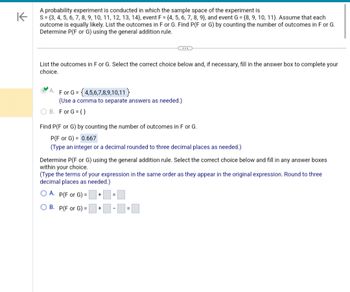
College Algebra
7th Edition
ISBN: 9781305115545
Author: James Stewart, Lothar Redlin, Saleem Watson
Publisher: Cengage Learning
expand_more
expand_more
format_list_bulleted
Question

Transcribed Image Text:K
A probability experiment is conducted in which the sample space of the experiment is
S=(3, 4, 5, 6, 7, 8, 9, 10, 11, 12, 13, 14), event F = {4, 5, 6, 7, 8, 9), and event G = {8, 9, 10, 11). Assume that each
outcome is equally likely. List the outcomes in F or G. Find P(F or G) by counting the number of outcomes in F or G.
Determine P(F or G) using the general addition rule.
List the outcomes in F or G. Select the correct choice below and, if necessary, fill in the answer box to complete your
choice.
F or G = {4,5,6,7,8,9,10,11}
(Use a comma to separate answers as needed.)
B. For G = {}
Find P(F or G) by counting the number of outcomes in F or G.
P(F or G) = 0.667
(Type an integer or a decimal rounded to three decimal places as needed.)
Determine P(F or G) using the general addition rule. Select the correct choice below and fill in any answer boxes
within your choice.
(Type the terms of your expression in the same order as they appear in the original expression. Round to three
decimal places as needed.)
OA. P(F or G) =
B. P(F or G) =
+
+
=
Expert Solution
This question has been solved!
Explore an expertly crafted, step-by-step solution for a thorough understanding of key concepts.
This is a popular solution
Trending nowThis is a popular solution!
Step by stepSolved in 4 steps

Knowledge Booster
Similar questions
- A binomial experiment is UDC in which there are exactly __________ outcome. One outcome is called __________ , and the other is called ___________.arrow_forwardShow that the probability of drawing a club at random from a standard deck of 52 playing cards is the same as the probability of drawing the ace of hearts at random from a set of four cards consisting of the aces of hearts, diamonds, clubs, and spades.arrow_forwardIf a binomial experiment has probability p success, then the probability of failure is ____________________. The probability of getting exactly r successes in n trials of this experiment is C(_________, _________)p (1p)arrow_forward
arrow_back_ios
arrow_forward_ios
Recommended textbooks for you
 College AlgebraAlgebraISBN:9781305115545Author:James Stewart, Lothar Redlin, Saleem WatsonPublisher:Cengage LearningAlgebra & Trigonometry with Analytic GeometryAlgebraISBN:9781133382119Author:SwokowskiPublisher:Cengage
College AlgebraAlgebraISBN:9781305115545Author:James Stewart, Lothar Redlin, Saleem WatsonPublisher:Cengage LearningAlgebra & Trigonometry with Analytic GeometryAlgebraISBN:9781133382119Author:SwokowskiPublisher:Cengage
 Holt Mcdougal Larson Pre-algebra: Student Edition...AlgebraISBN:9780547587776Author:HOLT MCDOUGALPublisher:HOLT MCDOUGAL
Holt Mcdougal Larson Pre-algebra: Student Edition...AlgebraISBN:9780547587776Author:HOLT MCDOUGALPublisher:HOLT MCDOUGAL College Algebra (MindTap Course List)AlgebraISBN:9781305652231Author:R. David Gustafson, Jeff HughesPublisher:Cengage Learning
College Algebra (MindTap Course List)AlgebraISBN:9781305652231Author:R. David Gustafson, Jeff HughesPublisher:Cengage Learning

College Algebra
Algebra
ISBN:9781305115545
Author:James Stewart, Lothar Redlin, Saleem Watson
Publisher:Cengage Learning

Algebra & Trigonometry with Analytic Geometry
Algebra
ISBN:9781133382119
Author:Swokowski
Publisher:Cengage


Holt Mcdougal Larson Pre-algebra: Student Edition...
Algebra
ISBN:9780547587776
Author:HOLT MCDOUGAL
Publisher:HOLT MCDOUGAL

College Algebra (MindTap Course List)
Algebra
ISBN:9781305652231
Author:R. David Gustafson, Jeff Hughes
Publisher:Cengage Learning